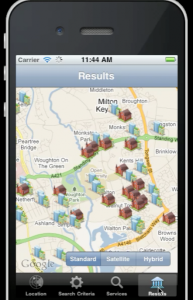News Story
KMi Releases Linked Services iPhone App
Thursday 23 Jun 2011
Last month saw the release of SOA4RealEstate in the iTunes App Store, an iPhone application that allows users to make informed decisions when looking for a property to buy in the UK. The app, which was demo-ed during John Domingue’s inaugural lecture held last week, allows users to combine on demand linked data coming from UK’s initiative towards exposing governmental data, together with added-value information provided by third-party Web APIs. In particular, the application currently mashes up data about properties coming from Nestoria’s Web API, together with linked data about train stations, bus stations, and schools available at data.gov.uk. SOA4RealEstate was developed during the last months of the SOA4All project jointly by TIE (NL), Hanival (AU) and our very own Carlos Pedrinaci, Ning Li and Dong Liu. The application explores and tries to leverage the complementarity between linked data and services on the Web. It builds upon KMi’s linked services infrastructure such as iServe in order to discover suitable Web APIs which are invoked on the fly and are mashed up with third-parties’ linked data, making the user experience as pleasant as possible by abstracting away the technical details related to this data and services integration. On the basis of these core technologies the application is ready for integrating new sources of data by simply publishing to our registry new service annotations in terms of the ontology that drives the App. This feature which is highly valuable for mobile devices demonstrates how, by means of our linked services technologies, applications can seamlessly evolve without requiring any code modification.
Connected
Latest News
KMi’s Dr. Retno Larasati Delivers Keynote on ‘Ethics in AI Education’ at ICONSEIR 2025
Celebrating Ortenz Rose: 45+ Years at The Open University
Transforming transport with AI: KMi and ClearView’s vision for smart cities











